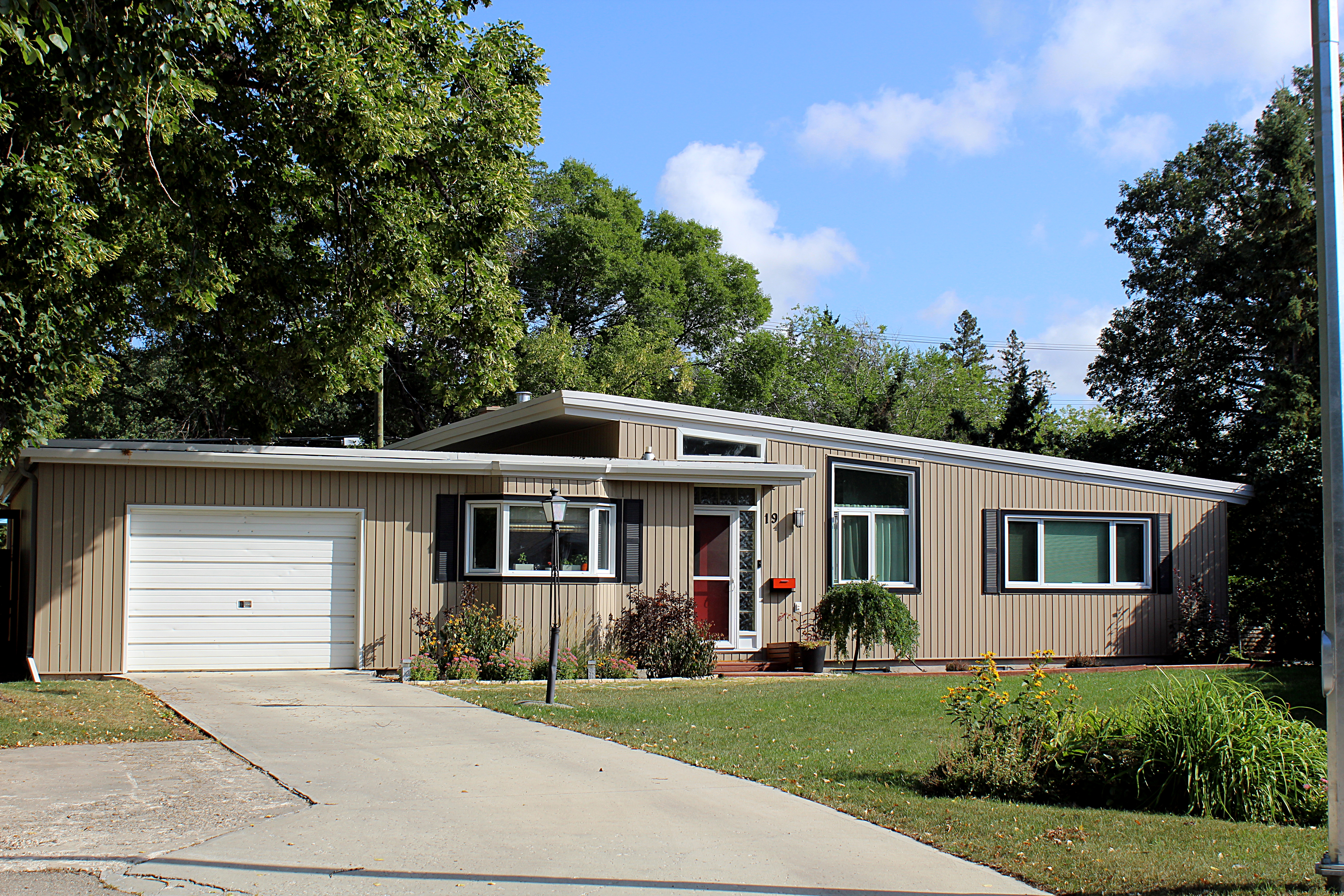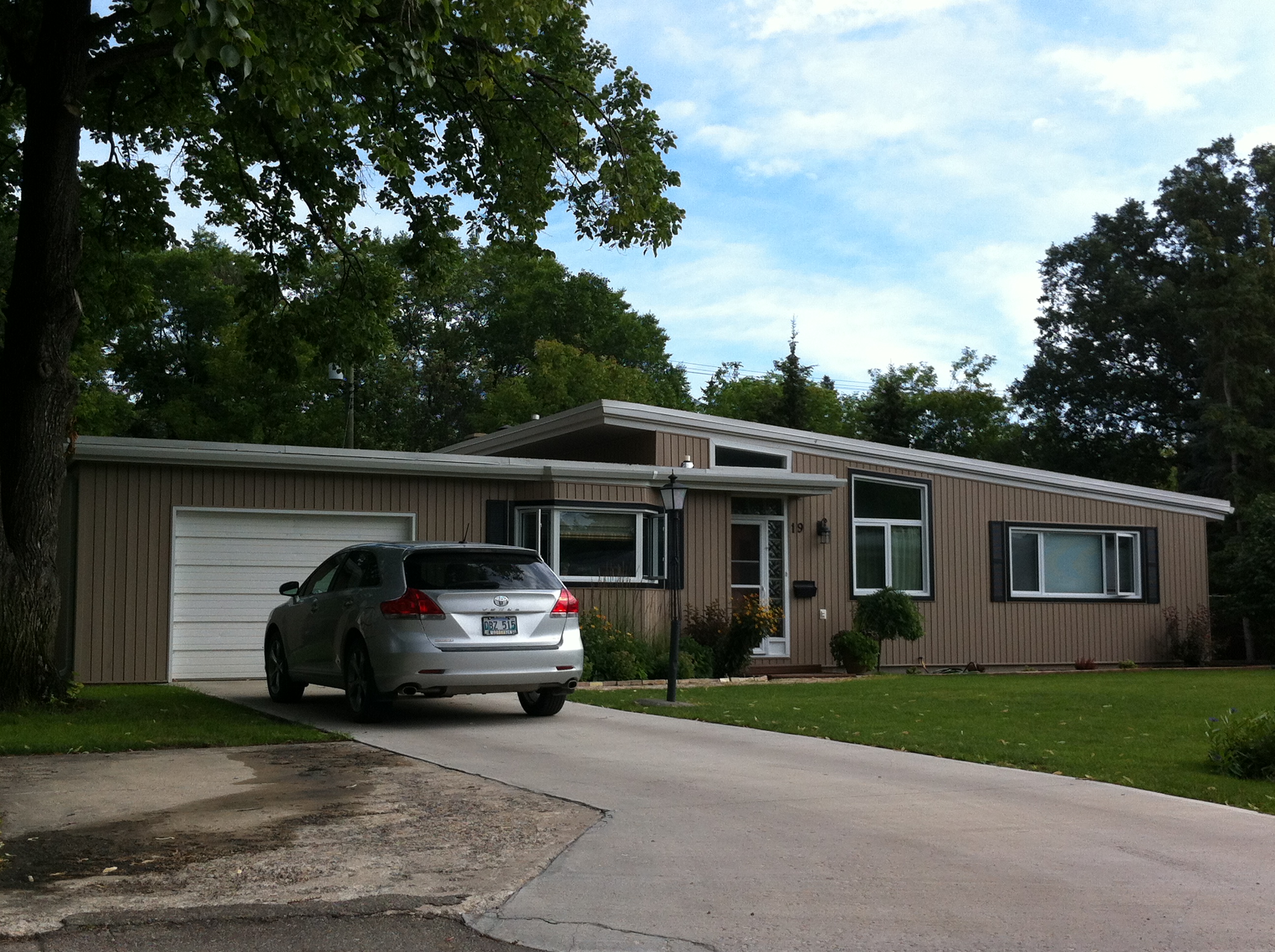Buildings
19 Mohawk Bay
| Constructed: | 1956 |
|---|---|
| Architects: | Nikola Zunic |
More Information
The home at 19 Mohawk Bay was featured in the Winnipeg Free Press on October 6, 1962—six years after its construction. It was touted as having “achieved the utmost in privacy for family living indoors and out.” The home sits on a wedge-shaped lot, backing onto the Windsor Park Golf Course. The exterior of the T-shaped structure originally featured white stucco with cedar siding.
The floor plan shows kitchen, dining, and living rooms on the main floor, in addition to three bedrooms. The living room contained a fireplace made of gold- and pink-toned brick; windows face the trees that line the golf course. The basement contained a large rumpus room—now often referred to as the recreational room—as well as a smaller play area for the children. The furnishing of the rumpus room included black and red linoleum with matching checkerboard curtains and black walnut finishings on one of the walls. Another wall featured cedar siding that was meant to provide a “ranch fence effect.” This “fence” was then topped with plywood cutouts in the shape of cocktail, wine, and beer glasses.
The original owners, Mr. and Mrs. Andrews, were involved with the design of the home. Mrs. Andrews had the idea of placing the kitchen to the left of the front door while Mr. Andrews asked for a nook with built-in seating around the two walls. While it is often the designers—in this case Zunic—that take the credit for successful residential developments, 19 Mohawk Bay offers one of many examples that demonstrate the collaboration between builder and client.
Few alterations have been made to the front façade of the home, aside from the conversion of the carport into a garage and the recladding.
Niakwa Park is located north of Fermor Avenue, south of Windsor Park Golf Course, and adjacent to the Seine River. This park-like neighbourhood was developed in the mid-1950s. When it was proposed, the project aimed to construct 160 homes on 16.2 acres of land. The area’s homes were designed by Nicola Zunic, a 1950 graduate of the University of Manitoba’s School of Architecture. The subdivision’s name is derived from an Indigenous term for “winding river,” and had earlier been applied to the Niakwa Country Club, established in 1921 and located south of Niakwa Park.
The construction of Niakwa Park was a direct result of a large population boom in St. Boniface during the post-war era. The number of people living in the municipality, which was amalgamated with the City of Winnipeg in 1971, increased by nearly 20,000 between 1951 and 1969. This growth rate significantly exceeded that of Metropolitan Winnipeg as a whole, resulting in an increase in housing development projects. One of these projects was Niakwa Park, approved by St. Boniface City Council in 1954. Niakwa Park Limited (then the Niakwa Park Syndicate) agreed to spend roughly $130,000 on roads and improvements including, as part of the agreement, constructing an extension of Archibald Street connecting it to the Trans-Canada Highway.
The subdivision was developed by Niakwa Park Limited. Beyond Zunic, partners in the area’s construction included: Johanson Construction; builders T. Urbanksi, J.Brown, and the Heintz Brothers; J. Les Thompson & Son; and, Thompson Lumber & Fuel Limited. Lorne Thompson, of the latter company, was an early leader in the area’s construction and orchestrated the purchase of the neighbourhood’s lots from the City of St. Boniface. The initial investment in the neighbourhood was $2,250,000, with homes selling for $13,000 to $15,000.
Of Niakwa Park, Zunic stated that he and his partners attempted to engender a certain diversity in design and wanted to embrace the park-like terrain, achieved partly by building around existing trees. Years later, Zunic commented further on the creative approach taken in the design: “it was our plan that we wouldn’t set up the houses like soldiers.”
Design Characteristics
| Size: | One storey 1,458 square feet |
|---|---|
| Developer: | Niakwa Park Limited |
| Suburb: | Niakwa Park |
| Frontage Direction: | South |

